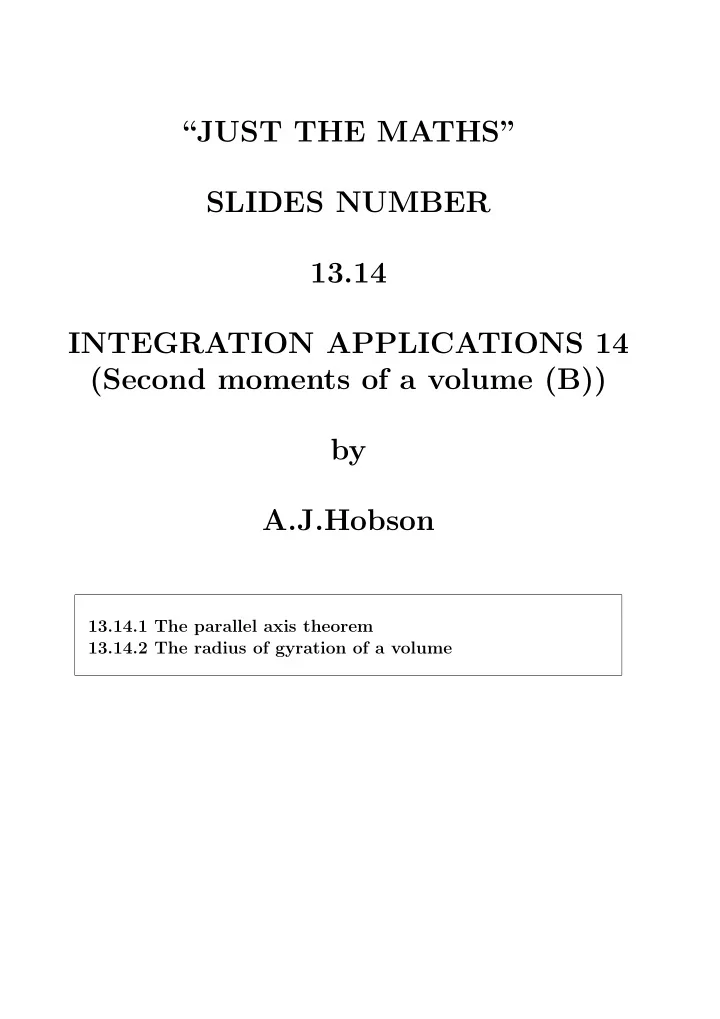

“JUST THE MATHS” SLIDES NUMBER 13.14 INTEGRATION APPLICATIONS 14 (Second moments of a volume (B)) by A.J.Hobson 13.14.1 The parallel axis theorem 13.14.2 The radius of gyration of a volume
UNIT 13.14 - INTEGRATION APPLICATIONS 14 SECOND MOMENTS OF A VOLUME (B) 13.14.1 THE PARALLEL AXIS THEOREM Suppose that M g denotes the second moment of a given region, R, about an axis, g , through its centroid. Suppose also that M l denotes the second moment of R about an axis, l , which is parallel to the first axis and has a perpendicular distance of d from the first axis. ✡ ✡ ✡ ✡ ✡ ✡ ✡ ✡ δV • centroid ✡ ✡ ❤ ✡ ✡ ❛❛❛❛❛❛❛❛❛❛❛ ❅ ✡ ✡ r l d ❅ ✡ ✡ r g ❅ ✡ ✡ ❅ ✡ ✡ ❅ ❛ θ ✡ ✡ h ✡ ✡ g l ✡ ✡ In the above three dimensional diagram, we have R r 2 R r 2 M l = l δV and M g = g δV. � � 1
But, from the Cosine Rule, g + d 2 + 2 r g d cos θ. g + d 2 − 2 r g d cos(180 ◦ − θ ) = r 2 r 2 l = r 2 Hence, g + d 2 + 2 dh ; r 2 l = r 2 and so R r 2 R r 2 R d 2 δV + 2 d l δV = g δV + R hδV � � � � Finally, the expression R hδV � represents the first moment of R about a plane through the centroid which is perpendicular to the plane contain- ing l and g . Such a first moment will be zero and hence, M l = M g + V d 2 . 2
EXAMPLE Determine the second moment of a solid right-circular cylinder about one of its generators (that is, a line in the surface, parallel to the central axis). Solution r h The second moment of the cylinder about the central axis was shown in Unit 13.13, section 13.13.2, to be πa 4 h . 2 Since the central axis and the generator are a distance a apart, the required second moment is given by πa 4 h + ( πa 2 h ) a 2 = 3 πa 4 h . 2 2 3
13.14.2 THE RADIUS OF GYRATION OF A VOLUME Having calculated the second moment of a three-dimensional region about a certain axis, it is possible to determine a positive value, k , with the property that the second mo- ment about the axis is given by V k 2 , where V is the total volume of the region. We simply divide the value of the second moment by V in order to obtain the value of k 2 and hence the value of k . The value of k is called the “radius of gyration” of the given region about the given axis. Note: The radius of gyration effectively tries to concentrate the whole volume at a single point for the purposes of consid- ering second moments; but, unlike a centroid, this point has no specific location. 4
EXAMPLES 1. Determine the radius of gyration of a solid right-circular cylinder with height, h , and radius, a , about (a) its own axis and (b) one of its generators. Solution r h Using earlier examples, together with the volume, V = πa 2 h , the required radii of gyration are (a) � � πa 4 h ÷ πa 2 h = a � � � √ � 2 2 and (b) � � � 3 πa 4 h � 3 � � � � � ÷ πa 2 h = a � 2 . � � 2 5
2. Determine the radius of gyration of the volume of rev- olution about the x -axis, of the region bounded in the first quadrant by the x -axis, the y -axis, the line x = 1 and the line whose equation is y = x + 1 . Solution y ✻ � � � ✲ x O 1 From Unit 13.13, section 13.13.3, the second moment about the given axis is 31 π 10 . The volume itself is given by 1 π ( x + 1) 3 = 7 π � 1 0 π ( x + 1) 2 d x = 3 . 3 0 Hence, � k 2 = 31 π 10 × 3 7 π = 93 � 93 � � 70 and so k = 70 ≃ 1 . 15 � � 6
Recommend
More recommend